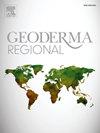碳信用难题:应该使用哪种分析方法来测定南非的土壤有机碳含量?
IF 3.3
2区 农林科学
Q2 SOIL SCIENCE
引用次数: 0
摘要
土壤有机碳(SOC)含量的准确量化是碳信用评价的基础。在南非,碳信用评估的标准方法没有规定应该使用哪种分析方法来确定碳含量。本研究旨在确定碳信用评估中应采用何种分析方法来确定碳有机碳含量。其次,确定土壤传递函数能否用于不同方法间有机碳含量值的传递。采用Walkley-Black湿氧化法(WB)、全干燃烧法(TDC)和燃失法(LOI)分析了220个表层土壤(0-30 cm)的有机碳含量。研究发现,TDC方法仍应被视为确定南非碳信用额评估中有机碳含量的首选方法。如果期望土壤具有较高的有机碳含量,则应避免使用WB法,而LOI法仍可用于测定SOM,但在测定有机碳含量时应避免使用该方法。该研究还通过成功地在所有三种方法之间创建土壤传递函数实现了第二个目标。然而,只有WB和TDC方法具有很强的相关性(R2 = 0.91),并且表明当SOC含量为2.5%时,准确度开始显著下降。因此,pedotransfer函数(SOCWB = - 0.157 + 0.895 x SOCTDC - 0.0149 x SOCTDC2-0.000606 x SOCTDC3)可用于转移SOC含量值,SOC含量最高可达2.5%。本文章由计算机程序翻译,如有差异,请以英文原文为准。
The carbon credit conundrum: Which analytical method should be used for determining soil organic carbon content in South Africa?
Accurate quantification of soil organic carbon (SOC) content is essential for the assessment of carbon credits. In South Africa, the standard methodologies for carbon credit assessment does not specify which analytical method should be used for determining SOC content. The study aimed to determine which analytical method should be used for determining SOC content for the assessment of carbon credits. Secondly, it determined whether pedotransfer functions could be used for transferring SOC content values between methods. Two-hundred-and-twenty topsoil (0–30 cm) samples were collected and analysed for SOC content with the three analytical methods: Walkley-Black wet-oxidation (WB), total dry combustion (TDC) and loss-on-ignition (LOI). The study found that the TDC method should still be considered the preferred method for determining SOC content for the assessment of carbon credits in South Africa. The WB method should be avoided if a soil is expected to have a high SOC content, while the LOI method could still be used for determining SOM, however, this method should be avoided when determining SOC content. The study also reached the second aim by successfully creating pedotransfer functions between all three methods. However, only the WB and TDC methods had a very strong relationship (R2 = 0.91) and showed that accuracy start to decrease significantly after 2.5 % SOC content. Therefore, the pedotransfer function (SOCWB = −0.157 + 0.895 x SOCTDC – 0.0149 x SOCTDC2–0.000606 x SOCTDC3) could be used for transferring SOC content values with SOC content up to 2.5 %.
求助全文
通过发布文献求助,成功后即可免费获取论文全文。
去求助
来源期刊

Geoderma Regional
Agricultural and Biological Sciences-Soil Science
CiteScore
6.10
自引率
7.30%
发文量
122
审稿时长
76 days
期刊介绍:
Global issues require studies and solutions on national and regional levels. Geoderma Regional focuses on studies that increase understanding and advance our scientific knowledge of soils in all regions of the world. The journal embraces every aspect of soil science and welcomes reviews of regional progress.
 求助内容:
求助内容: 应助结果提醒方式:
应助结果提醒方式:


